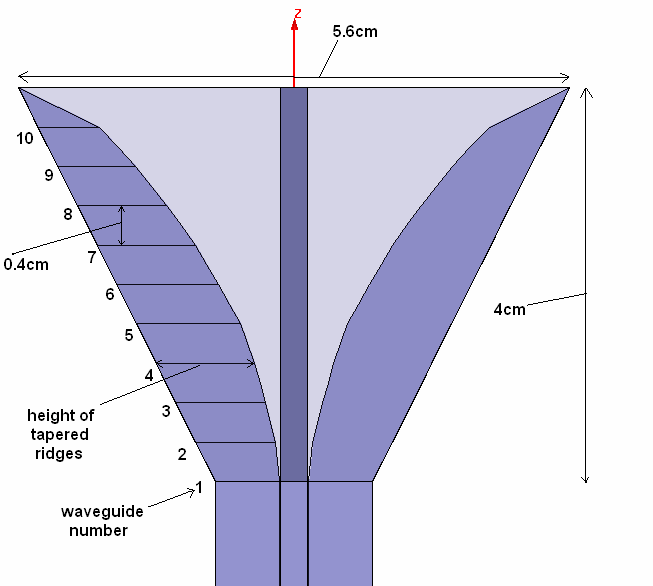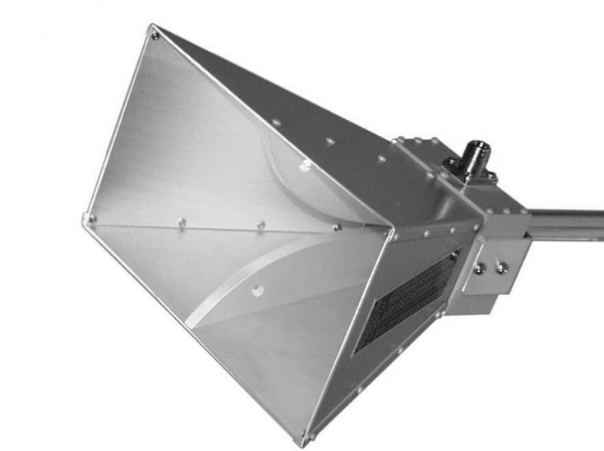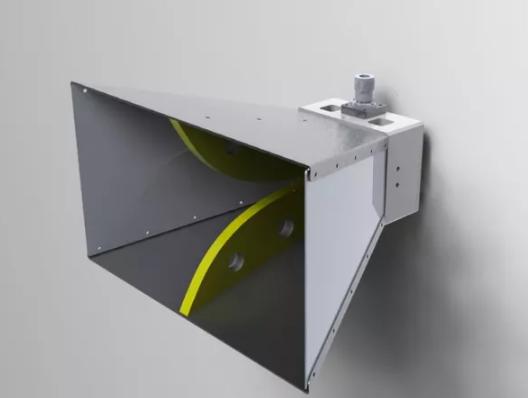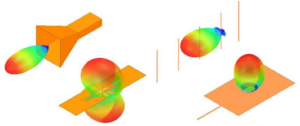A double-ridged horn antenna is a broadband antenna typically operating between 1 GHz and 18 GHz, offering gains of 10 to 20 dBi. It features a unique ridged design that enhances bandwidth and reduces signal loss, making it ideal for applications like EMC testing and radar systems, where precise, long-range signal transmission is crucial.
Design
The most important factor in high performance over extremely wide frequency ranges is the double-ridge horn antenna design. Unlike standard horn antennas, which may cover frequencies around 2 GHz to 10 GHz, the standard double-ridged horn antennas are designed to operate over extremely wide frequency ranges, typically from 1 GHz up to 18 GHz. This greater range of frequency makes the double-ridged horn antenna adaptable for such a great variety of uses: wireless communications, testing in electromagnetic compatibility, and radar systems are just a few examples. The ridged structure enhances the ability of the antenna to be consistent in performance, with return loss better than -20 dB for much of its operational range, ensuring that the reflection and loss of signal will be minimal.
For the gain, a double-ridge horn antenna usually ranges from 10 to 20 dBi. In that respect, for frequencies in the range of 1-18 GHz, one model would have its peak gain at 18 dBi at certain frequencies, which is highly suitable for applications that require a high-level signal transmission and reception. This kind of gain becomes necessary when the level of a signal is reduced due to the distance factor or barriers. The radiation pattern is usually conical, and the half-power beamwidth is normally in the range of 30 to 60 degrees, allowing for focused transmission and reception in targeted directions.
Size and weight are other key factors in the design of double-ridged horn antennas. The general dimensions are normally along the lines of 50 cm in length, 30 cm in width, with a weight that may lie between 5 to 10 kg. While this makes them less portable compared to simpler antennas, the design allows for effective handling in professional settings. Some portable models have been engineered to be lighter and more compact, weighing about 3 to 4 kgs while retaining fairly good performance metrics. However, these portable options often include trade-offs in terms of gain and frequency coverage. Typically, you get a narrower frequency range from about 2 to 10 GHz.

Broadband Capability
With their high broadband capability, double-ridge horn antennas differ from regular antennas and find their ideal application in a number of particular cases that require wide frequency coverage. Commonly, these antennas can operate within the frequency range from 1 GHz to as high as 18 GHz. Such wide bandwidth comes because of their special ridged design, which does not support signal loss and keeps the performance consistent throughout all frequencies. Whereas a typical horn antenna may have a bandwidth of only a few GHz, for example, a double-ridged design often provides a bandwidth three to four times broader. This capability certainly finds great applicability where various systems of communication work in an environment such as in radar and wireless networks.
Another important vital factor of double-ridge horn antennas is return loss, underlining their broadband capability. A good design for a double-ridged antenna can achieve return loss better than -20 dB for much of its operational range, less than 1% being reflected back toward the source. It guarantees that most of the power can be effectively transmitted. For reference, classic antennas could have losses greater than -10 dB, increasing the reflections of the signal, hence decreasing their efficiency. It can perform with low return loss across a wide frequency range with the double-ridged antenna. This gives more reliable performance in applications like electromagnetic compatibility testing, where accurate measurements are utmost important.
On the gain note, double-ridged horn antennas normally offer a gain from 10 dBi to 20 dBi. The consequence could be that this antenna, for example, intended for 1-18 GHz, may exhibit peaks in gain for certain frequencies, reaching a maximum of 18 dBi and hence strong signals ideal for transmission and reception. Such a gain advantage is very important in many applications where the signal has to travel very long distances or through obstacles, like urban or industrial environments. Because this is a focused gain, it allows the usage of power efficiently, thus making these antennas quite suitable in power-sensitive applications in telecommunications.

Gain
The double-ridge horn antennas have a gain factor, which is significant in so many different applications: telecommunication, radar, EMC testing. Normally, for such antennas, the gain is from 10 dBi up to 20 dBi, and for some special models, it can be even higher. In a certain antenna model, for the frequency of 1 GHz-18 GHz, the peak gain may hit at 18 dBi for particular frequencies. The significant gain means this antenna amplifies the signal it finally sends into space. It would prove to be exceptionally useful in situations that call for long-range communication or where signals are forced to bypass various obstacles.
An excellent example would come from wireless communication systems with its good promise for usage in this range and clarity of signals. A typical double-ridge horn antenna with 15 dBi gain can establish a link over a distance of about 20 kilometers in open areas, provided that line-of-sight conditions exist. A low-gain antenna, say about 5 dBi, may give coverage to approximately 5-km-distance under similar conditions. It is this extended range with higher gain that could very radically improve the performance of communication systems to be much stronger and more reliable, especially in areas far from cities.
Besides, the gain also affects the efficiency of the signal in radar applications. Therefore, it would mean that this double-ridged horn antenna with 20 dBi gain, for a radar system, would serve to increase the effective power by focusing energy in a narrow beam, finding objects much further away and with higher resolution. The reason for this is perhaps best illustrated by considering, for example, the difference between the target detection range performance of a high gain and a lower-gain antenna in the case of a radar system operating at frequencies up to 10 GHz. Assuming a high gain double-ridged horn antenna would grant target detection beyond 50 kilometers, a low-gain counterpart of that antenna would effectively reach targets only up to 20 kilometers.
Of course, the other important feature is the radiation pattern associated with the gain of double-ridged horn antennas. Generally, the radiation pattern from double-ridge horn antennas would be a cone. The half-power beamwidth usually ranges from 30 to 60 degrees. This small beamwidth will permit fine tuning of the signals toward targets, which again would be crucial in applications related to point-to-point communication and radar tracking.

Directionality
Probably one of the most salient features of double-ridged horn antennas is directionality, a factor that greatly extends its functionality to host a wide range of applications, especially in communications, radar, and electromagnetic compatibility testing. By their design, these antennas can focus their energy output in certain directions, which makes them very effective in point-to-point communications and in sending signals over a long distance. In fact, the nominal half-power beamwidth of a double-ridged horn antenna lies in between 30 to 60 degrees, meaning most of the signal energy can be confined within this angular range. This focused pattern therefore allows very precise targeting of the signals, which becomes fundamentally necessary when clarity and distance become of essence.
Practically, directionality in such antennas greatly influences their performance in wireless communication systems. For example, for a double-ridged horn antenna with 15 dBi gain, this can support links over distances up to 20 kilometers under very ideal conditions. Where there is a wide beamwidth such as 90 degrees, then normally the gains are much lower at about 5 dBi, and accordingly the effective range supported will be only about 5 to 10 kilometers. This discrepancy points to one of the most important aspects of directionality—a narrow beamwidth maximizes signal strength and reduces interference from unwanted sources.
In radar applications, directionality provided by the double-ridged horn antennas allows provision for enhanced target detection and tracking capability. The double-ridge horn antenna may be useful at a frequency of, say, 10 GHz while focusing its energy into a narrow beam and, hence, increasing the detectability by the radar systems of a small or far-off target. Such a narrow beam may extend the range of the radar beyond 50 km unlike the broader beam antennas whose effective detection may lie within only 20 km. This capability is especially valued in military and aerospace for accurate target tracking.
Applications
Double-ridge horn antennas are fairly versatile; hence, they find applications in many industries due to their very wide frequency range, high gain, and great directionality. Among the major areas of use of double-ridge horn antennas is EMC testing. In this respect, the double-ridge horn antennas serve within the frequency range from 1 GHz up to 18 GHz and, therefore, are suited for tests of electronic devices in accordance with EMI. A typical configuration would be the measurement of radiated emissions using a double-ridged horn antenna from an electronic device to meet international standards such as CISPR 22. In fact, these antennas provide return losses better than -20 dB and hence are able to measure the correct value of weak signals that usually get masked by background noise.
In telecommunication, double-ridged horn antennas play a pivotal role both at the transmission and reception ends. These antennas normally have gains in the range from 10 dBi to 20 dBi, therefore allowing for long-range communication links. In a wireless communication setup, an example can be that with a double-ridged horn antenna with a gain of 15 dBi, effective communication can easily be maintained up to 20 kilometers provided the line of sight is clear. This makes them very suitable for a wide range of applications, ranging from point-to-point microwave links—where maintenance of high data integrity over long distances is imperative—to other applications. In most urban areas, these are normally afflicted with obstacles; the concentrated beam provided by these antennas tends to reduce some signal losses and generally enhance reliability.
The radar systems constitute another critical application area for double-ridged horn antennas. These antennas find wide applications in both civilian and military radar systems for better target detection and tracking. For example, a high-gain double-ridged horn antenna can extend the radar detection capability at about 10 GHz frequency for target identifications beyond 50 kilometers. This performance is essential in applications involving air traffic control, where the correct tracking of aircraft is incredibly important in terms of safety and efficiency. This is enabled by the conical radiation pattern, allowing for effective scanning over large areas, which makes them quite indispensable in missions requiring surveillance and reconnaissance.
Advantages
Double-ridged horn antennas provide several features that make them highly suitable for many high-frequency applications. Among the major benefits, one must note that they are effective in offering wide bandwidth. Their operating range usually starts from 1 GHz to as high as 18 GHz. The wide bandwidth can allow simultaneous transmission and reception of multiple frequency signals, which is a crucial need for modern communication systems reliant on multiple bands of frequencies. For instance, this means that in wireless communication setups where large frequency coverage is realized, a single double-ridged horn antenna acts to simplify the system architecture by covering all those frequencies that would otherwise require several antennas. This minimizes the overall cost. Besides, since the design of these antennas is efficient, the need for complex matching networks is minimized, hence improving the performance of the system.
Another major advantage of double-ridged horn antennas is that they possess high gain characteristics. Most of these antennas have a gain in the order of 10 dBi up to 20 dBi, which increases their capability in transmitting and receiving signals over a long distance. A double-ridged horn antenna with a gain of 15 dBi can work effectively at distances up to 20 kilometers under line-of-sight propagation conditions. This feature becomes very useful when dealing with point-to-point microwave communication applications where the main goal is to keep the signal strong enough for such range. This high gain extends the range and, simultaneously, improves the signal-to-noise ratio, enabling better and clearer communications even in difficult environments.
Another advantageous feature of double-ridged horn antennas is their directionality. This class of antenna normally has a half-power beamwidth from 30 to 60 degrees, meaning it may effectively focus its radiation pattern in certain directions. This concentrated directionality is the key to systems that operate on targets to identify and locate them, such as radar systems. For example, a double-ridge horn antenna could realize effective target detection over 50 kilometers away in a radar system, while similar but wider beamwidth antennas degrade the performance. By focusing the energy, it reduces interference with unwanted signals and hence makes these antennas highly efficient for many applications of surveillance and monitoring.
Pros and Cons
Double-ridge waveguide horn antennas possess several advantages that make them quite favorable for many applications. There are, nevertheless, several limitations that this antenna possesses. First of all, the major advantage of double-ridge waveguide horn antennas is the wide bandwidth capability they have, normally from 1 GHz to 18 GHz. An exceptional range of frequency allows handling with multiple signals at the same time, which is especially highly effective in modern communication systems where many frequencies are in frequent use. It is here that double-ridged horn antennas come into play during EMC testing: allowing engineers to work with the devices within wider spectrums of frequencies, thus saving the need for several antennas and tangle accompanying their use. Apart from that, the return loss is usually greater than -20 dB to ensure that energy loss due to reflection is minimum for better system efficiency.
The key features of double-ridged horn antennas are their high gain characteristics. Such types of antenna can provide a gain ranging between 10 dBi to 20 dBi, offering very solid signal strength at very long distances. As an example, a double-ridged horn antenna with gain up to 18 dBi supports the distances of effective links as long as 20 km under line-of-sight conditions. These high gains become unavoidable in some applications, such as point-to-point microwave communication, where received signal integrity is crucial. Also, their focused radiation pattern contributes to less interference from undesirable sources; hence, clearer signal reception in a more duly congested environment is quite big a deal for an urban setting with several competing signals.
Notwithstanding all these advantages, double-ridged horn antennas exhibit some drawbacks. One notable disadvantage of a double-ridged horn antenna is its physical size and weight. Ordinarily, antennas are sizeable and of greater weights compared to these simpler variants. Its actual size reaches about 50 cm with a total weight ranging between 5 and 10 kg. Considering this in terms of physical dimension may not make this size portable for on-hand use in any type of application with space restraints. Their mounting becomes tricky as the transportation itself turns into something that hinders their immediate deployment on sites that will require an easily movable component such as its equipment.







